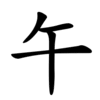午
| ||||||||
Translingual
| Stroke order | |||
|---|---|---|---|
| Stroke order | |||
|---|---|---|---|
 | |||
Han character
午 (Kangxi radical 24, 十+2, 4 strokes, cangjie input 人十 (OJ) or X人十 (XOJ), four-corner 80400, composition ⿱𠂉十 or ⿰丿干)
References
- KangXi: page 156, character 4
- Dai Kanwa Jiten: character 2703
- Dae Jaweon: page 354, character 1
- Hanyu Da Zidian (first edition): volume 1, page 406, character 1
- Unihan data for U+5348
Chinese
| simp. and trad. |
午 | |
|---|---|---|
Glyph origin
| Historical forms of the character 午 | |||
|---|---|---|---|
| Shang | Western Zhou | Shuowen Jiezi (compiled in Han) | Liushutong (compiled in Ming) |
| Oracle bone script | Bronze inscriptions | Small seal script | Transcribed ancient scripts |
 |
 |
 |
 |
Etymology 1
Norman (1985) proposed connection with Austroasiatic; Ferlus (2013) noted a "[g]ood correspondence" between Proto-Vietic *m-ŋəːʔ (whence Vietnamese ngựa) and Old Chinese reconstructions like *m-qʰˁaʔ (Baxter-Sagart) and *ᵀs.ŋaʔ (Ferlus). Also compare Proto-Hlai *hŋaːʔ (“horse”), Proto-Kra *ŋja C (“horse”).
Alternatively, Smith (2011) proposed 午 (OC *ŋaːʔ)'s cognacy with 啎 (OC *ŋaːs) "to meet head on" and 御 (OC *ŋas) "to meet in (battle)" and suggested that "the moon at its full phase opposes the sun directly in the sky, meaning *ŋaaʔ 午 is probably to be glossed, given *-ʔ , ‘facing stage’". Schuessler (2007) regarded 午 (OC ŋâh) "to go against" as a mere graphic variant of 啎 and thus deemed the sense "to go against" distinct from the "earthly branch" sense.
Pronunciation
Definitions
午
Coordinate terms
Compounds
Etymology 2
| For pronunciation and definitions of 午 – see 舞 (“to dance; dance; dancing; etc.”). (This character, 午, is the second-round simplified form of 舞.) |
Notes:
|
References
- “午”, in 漢語多功能字庫 (Multi-function Chinese Character Database), 香港中文大學 (the Chinese University of Hong Kong), 2014–
Japanese
Korean
Etymology
From Middle Chinese 午 (MC ŋuoX).
| Historical Readings | ||
|---|---|---|
| Dongguk Jeongun Reading | ||
| Dongguk Jeongun, 1448 | ᅌᅩᆼ〯 (Yale: ngwǒ) | |
Pronunciation
- (SK Standard/Seoul) IPA(key): [o̞(ː)]
- Phonetic hangul: [오(ː)]
- Though still prescribed in Standard Korean, most speakers in both Koreas no longer distinguish vowel length.